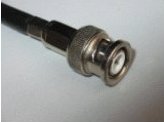
networking curriculum
support CD for senior
secondary studies
Topics
. Home
. Networking History
. Why network?
. OSI model
. Connecting up
. Protocols
. Technology
. Network types
. Topologies
. Issues
. Design factors
. Economic effects
. www links
. Site map
 networking >
connect up > 10Base-2-Coax BNC
networking >
connect up > 10Base-2-Coax BNC
10Base-2-Coax BNC
This is a cheap form of coaxial cable that has a central copper core with a special insulating plastic around it to control the impedance. A braided shield is then covered around the outside and another layer of plastic is placed over that.

The connectors used are BNC type with a bayonet push and twist to click it home.


The BNC socket at the back of a network card (note the card has two interface connections and is auto sensing. It automatically selects the connection that is active, so it could also use the CAT5-RJ45 system as well, but not the two of them simultaneously). The data rate is 10Mbits per second for either connection on these cards. More advanced cards will give 100Mbits or Giga bits data exchange rates and will not have the outdated coaxial connectors. Many of the 10/100 CAT5/RJ45 connections will have auto sensing speed detection.

The coaxial systems had one major advantage - the connecting coaxial cable media was cheap and easy to source. However the daisy chain connections between machines were very prone to disruption, because if any plugs were less than 100% connected, the entire length of the network ceased working.

The method of daisy chaining the lengths of cable together using BNC "T" connectors as demonstrated in the graphic.

A terminator will be required at the end of the cable segments to suppress signal echoes from the ends of the cable that will corrupt the signals on the line. The absence of terminators will cause the segment to cease working.
Other types of coaxial that are more common are the broadband connections that have tapped screw on connectors.

For example the use of broadband coaxial cable attaches to the high speed modem and is then distributed out through 10/100Mbit Ethernet using CAT5/RJ45 cable or USB. The photograph below illustrates the coaxial cable supplying the broadband connection and the subscriber connected through Ethernet CAT5/RJ45. Once the connection is made the subscriber can then use standard hub/switch type technology to distribute through the site. Users who might not have a network interface but have a USB port can use drivers that will allow a direct connection to the modem with a standard TCP/IP interface.

worksheets
. history
. why network
. osi model
. connecting
. protocols
. technology
. topologies (tla)
. issues
. network types
. design
. economics
. economics (cs)
- solutions -
quizzes
. why network
. osi model
. connecting
. protocols
. technology
. topology
. issues
. network types
. design
. economics
| Home |
History |
Why Network? |
OSI Model |
Connecting up |
Protocols |
Technology |
Networks Types |
Topologies |
Issues |
Design Factors |
Economic effects |
:: copyright |
credits |
sitemap ::
© 2003 Victorian Information Technology Teachers Association
http://www.vitta.org.au/
